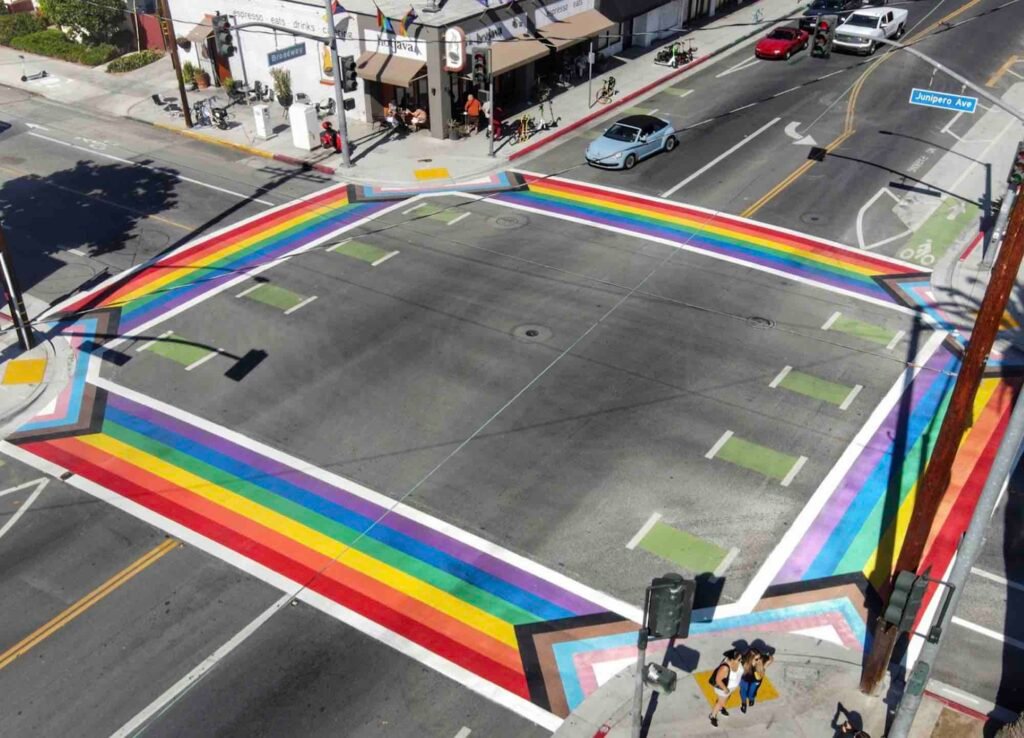There’s no Long Beach LGBTQ district—at least formally. In Chicago, it’s sentimentally called “Boystown” but formally dubbed Northalsted. In Montreal, it’s The Village. In San Jose, it’s called the QMunity District. And when it comes to Long Beach, it’s been lovingly called “The Gayborhood” by visitors and residents alike for decades. Some have also called it “Rainbow Row.” Others have just called it “The Neighborhood with All the Gay Bars.”
There is, however, no sanctioned, From-City-Hall designation for the stretch of Broadway between Junipero and Alamitos Avenues. But matter how the dubbing is designated, one thing is clear: That stretch is an essential part of the city’s cultural fabric—and it serves as the main thrust behind the City of Long Beach taking steps toward formally designating the space.

Preliminary plans for the Long Beach LGBTQ district move along
“The LGBTQ+ Cultural District will serve as an important symbol of inclusivity and pride in our community,” stated Vice Mayor Cindy Allen who represents City Council District 2, which encompasses the proposed District. “I encourage our community to review the report and stay involved in future engagement opportunities.”
The preliminary vision plan for the district is a bold take on a neighborhood that often has its history shrouded or kept from peeking eyes—and that is something both recognized by queers themselves, who feel a queer district should offer ways to learn about the city’s queer past, and their allies.
And it’s a beautiful thing to see a city document actively advertise that, first and foremost, queer history should be at the epicenter of a queer district. Yes, of course, the many physical things—like upgrading lighting a la West Hollywood’s stretch of Santa Monica or Nollendorfplatz in Berlin—are important, yes; even needed in many senses as such upgrades also create an uptick in safety.
But let’s not forget that history.
History saddles with the idea of a Long Beach LGBTQ district
For me, as both a queer resident and writer, there is a worthy weight that is slowly being lost when it comes to queer history and queer spaces.
This is not to dismiss the beauty of the newly found freedoms that the younger generation are rightfully exercising: PrEP has altered the many queer people can physically express their love, with HIV now becoming an entirely manageable disease. Holding hands in public is not just encouraged but outright common. Corporations, theme parks, sports teams, brand identities, and art have all taken on public stances in support of the queer community.
These are not to be dismissed—but in a survey last year regarding the proposed district here in Long Beach, a lot of young people wanted the same thing: “I wish I knew more of the history behind my community.”
And for me, Broadway Bar —the most westerly bar on the strip of Broadway that designates the good ol’ Gayborhood—was the first place in Long Beach that, when I was younger, taught me about history in a way only a queer bar could.

Yes, this dignifyingly divey, unapologetically un-modern, proudly pay-with-cash-only, stucco showcase unlike any other gave me one of my most important lessons. And it is something that all these enclaves, these rainbow dives, this dimly lit hideaway all encompass: For many, they are sacred spaces.
To put it bluntly, Broadway Bar was the first bar I had experienced a wake at.
The older queers—fairy old men, butchy old ladies, some trans folk, all races—were beyond welcoming to me, my 22-year-old lanky ass stumbling into the space as if it were my own while they has begun to set up food and arrange pictures of the one they lost. Their welcoming wasn’t required of them but they welcomed nonetheless—and it was likely because that type of welcoming was never afforded to them.
See, queer bars became the churches of the queer communities, the event venues of the queer communities, the holiday spaces of the queer community—because so much of society had shunned them beforehand. They literally had nowhere else to go.
And upon leaving that day, I returned home where I was lucky enough to live next to a gay couple—Larry and JR—and when I inquired about this wake, Larry took me upstairs where he had a small address book stashed in his drawer. Sure, I learned of the AIDS pandemic through books and watched about it through documentaries, but it was Larry who showed me firsthand the devastation by handing me a small address book.

“Anyone with a black X by their name…” he trailed off before being frank: “They died of AIDS.”
As I flipped through the book I was horrified to find not just a few names but page after page of men’s names marked with a subtle but clear black X. Even more heartbreaking was to hear Larry say, “There were days where I had to choose which funeral I was going to.”
These histories can’t be relegated to a serendipitous stumbling of a twenty-something unknowingly into a bar nor can it be relegated to the four walls of a very private gay couple who built up trust with their younger gay neighbor.
They need to be publicly recognized—and there really is no better space for Long Beach to share these histories than along the Broadway Corridor.
Just be proactive, Long Beach: Look at the preliminary plan for the district, know the people at City Hall you need to reach out—especially Vice Mayor Cindy Allen’s office—in order to speak your mind, and most of all, actually enjoy it when it comes to fruition.
Because as a queer kid who grew up on the mountain in Big Bear, I never thought I would live in a city where there was a formally sanctioned queer district. And that is pretty damn beautiful, girl.


